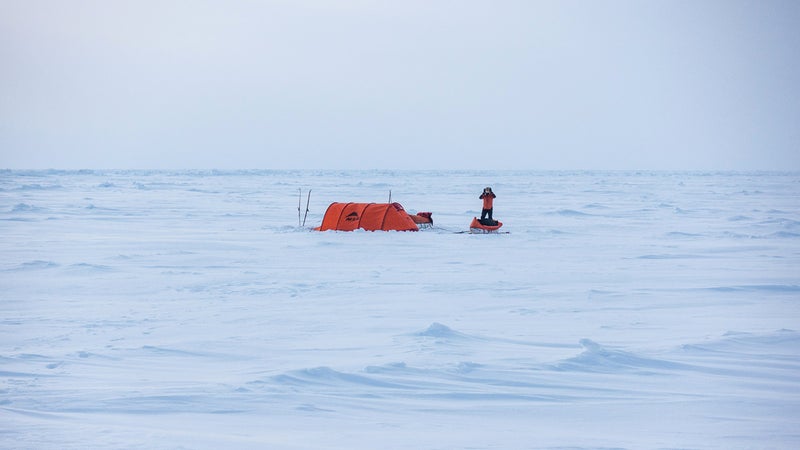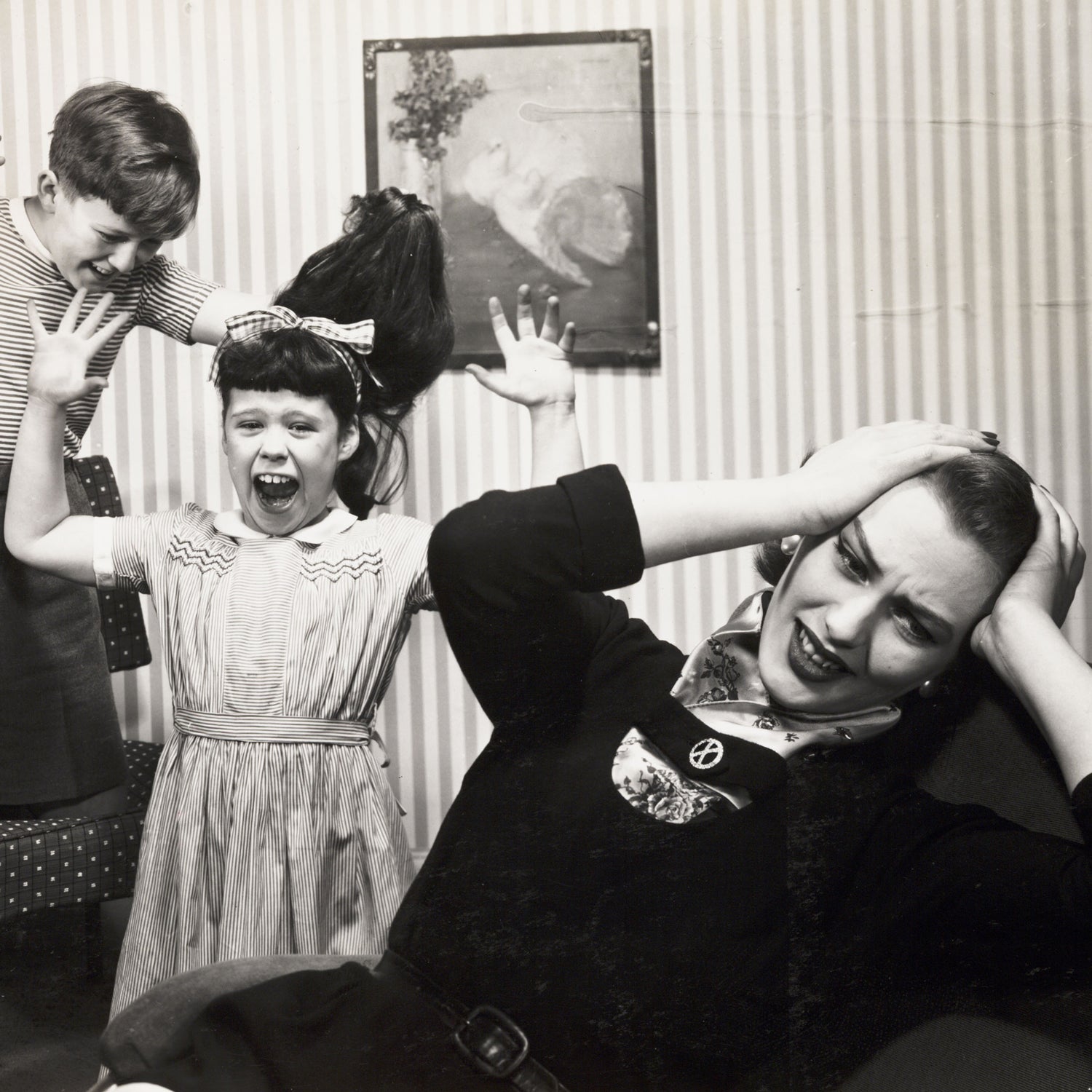The original goal was to be the first to cross the Arctic Ocean in the summer. But a couple of weeks into their 2005 expedition, polar adventurers Eric Larsen and Lonnie Dupre found themselves trapped on a small chunk of ice, waiting for a helicopter rescue instead. For nine days, Larsen says, he had nothing to do but sit in a tent listening to an MP3 player with a handful of albums on it. He couldn’t sleep, partly because he was crushed with disappointment. To pass the time, he started to ski tiny loops around the ice floe, then would sit on a sled until he got cold before skiing another lap.
Mentally, that time in limbo was much like what he’s experiencing now, sheltering in place in Crested Butte, Colorado, with his wife and two kids, the result of worldwide lockdowns to slow the spread of COVID-19. With no clear sign of when stay-at-home orders will end, his time in that tent—stuck, unsure of when a helicopter would arrive—echoes what Larsen’s going through in quarantine. “It’s just uncanny, the similarities and the emotional peaks and troughs that you go through,” he says.
What Larsen describes is a concept that’s now familiar to many of us: cabin fever. And as much of the world hunkers down under some level of quarantine, concerns have escalated about what the effects of so much isolation may be. Will incidences of depression, suicide, and other mental-health issues rise as a result of being cut off from friends, family, activities, and the outdoors? While studies of cabin fever and quarantine confirm that the psychological risks are real, there are also reasons for optimism.
Research on astronauts, explorers, Antarctic scientists, and others who have long lived in isolated and extreme situations suggest there are plenty of ways to get through uncertain times in close quarters with your sanity intact, says Emma Barrett, a psychologist at the University of Manchester in England and coauthor of Extreme: Why Some People Thrive at the Limits.
“People talk about how awful it’s going to be and how damaged people are going to be when they come out of this,” Barrett says. “Well, that’s not the case when you look at most extreme situations. The resilience, and coming out of it in a positive way, is much more common than having a negative reaction.”

What exactly is cabin fever? It isn’t a scientific term so much as a folk phrase that emerged from popular culture with some loose links to medical history. The phrase may have originated during typhoid outbreaks in the early 1800s. In 1820, a British publication called The Gentleman’s Magazine used cabin fever as a synonym for the disease. It wasn’t until 1918, according to Merriam-Webster, that the term was first used to refer to the extreme restlessness and irritability that can emerge from being confined indoors for a long time. Although cabin fever isn’t an official diagnosis, its well-known symptoms include irritability and restlessness, claustrophobia, depression, fatigue, paranoia, and a feeling of being trapped.
In the early 1980s, researchers at the University of Minnesota set out to learn more about cabin fever by observing how people deal with the state’s long, difficult winters—cold, dark stretches that often last half the year. They interviewed 35 men and women between the ages of 17 and 84. Results suggested that half of them experienced cabin fever, and they experienced it in similar ways: by losing their tempers, not getting anything done, and feeling bored, irritable, depressed, or dissatisfied. Those feelings might sound familiar to people currently living through shelter-in-place orders around the world.
“It’s not so much that you are confined to the house, but the fact that you can’t get away,” said one farmer interviewed for the study. “Just knowing the fact that, no matter what comes up, you can’t leave is probably more aggravating than anything else.”
But while some people who were interviewed reported sadness and low energy, others described cabin fever as simply something to get through. Paul Rosenblatt, an emeritus professor of psychology at the University of Minnesota who coauthored the study, interviewed one Swedish-American man in northern Minnesota who said that he first heard the term cabin fever in the early 20th century from lumberjacks in the area. Other respondents said they liked having the chance to plan vacations, be creative, or enjoy books, TV shows, and time with family. “Some seemed to gain or grow from their experience of cabin fever,” Rosenblatt says.
Cabin fever’s well-known symptoms include irritability and restlessness, claustrophobia, depression, fatigue, paranoia, and a feeling of being trapped.
Not everyone fares as well when cooped up. In research published in February, scientists from King’s College London analyzed 24 studies from ten countries that looked at the psychological effects of quarantine in response to SARS, Ebola, the H1N1 flu, MERS, and equine influenza. Most of the studies found negative reactions to quarantine, including depression, anger, fear, alcohol abuse, and symptoms of post-traumatic stress disorder. Healthcare workers and people with a history of psychiatric disorders were particularly vulnerable. Some symptoms persisted for months or years. Longer quarantines were linked to worse mental-health outcomes.
One study included in the review was conducted soon after SARS began to spread through Toronto in 2003. During the outbreak, the city ordered more than 15,000 people to stay home, where they were supposed to wash their hands frequently, wear masks around family members, and sleep in isolated rooms. Within a month or two after their quarantines lifted, researchers collected surveys from 129 people and found that nearly a third had experienced symptoms of depression and PTSD.
The COVID-19 lockdowns differ from the SARS quarantine in several ways, says study coauthor Laura Hawryluck, a critical-care physician at the University of Toronto. The city’s quarantine at that time targeted people who were most at risk, which increased fears among the quarantined that they might get sick or infect others. That’s different from what we’re experiencing today, in which almost the entire world is staying home. And people did not have as many ways to connect virtually then either—Facebook didn’t roll out until 2004—which made them even more isolated.
On the other hand, the current pandemic has affected more people in more places, with added concerns about insufficient protective gear for health care workers, a lack of treatments and ventilators for patients, and the global economic downturn. The differences make it hard to predict the psychological toll of COVID-19 quarantines, which Hawryluck and her colleagues are seeking funding to study. “We’ve all seen on TV the amount of death, and the sheer volume of this, and not knowing where it’ll end,” she says. “We’ve never dealt with it on this scale.”
While studies of people who spend time in isolated, confined, and extreme settings suggest that tough times do occur, scientists have yet to identify a consistent pattern of what to expect.
Nathan Smith, a research psychologist at the University of Manchester, has studied this question through the lens of adventure athletes. Smith coleads a research endeavor called the Expedition and Adventure Psychology Project with Emma Barrett. He says that, according to some theories, the beginning of an expedition is hardest because everything is so new. But according to other theories, the end is hardest because those involved know they’re going to be done soon and start to let down their emotional guard. There’s even evidence for what researchers call a “third-quarter phenomenon”—a dip in morale that can happen soon after the halfway point of an expedition, when people start to reflect on how much time is still left to go.
Regardless of when the lows and highs happen, it can be helpful to recognize that both are normal. “I think that’s quite empowering for people to know,” Smith says. “If you’ve had a rough day, tomorrow may well be better without having to do anything.”

As the six-week mark of lockdown nears for many U.S. communities, it’s also good to be aware of a turning point that often happens four to six weeks into space missions, says Nick Kanas, emeritus professor of psychiatry at the University of California at San Francisco, who has been studying astronauts since 1969 and has worked with NASA. As excitement wears off, irritability and annoyance ramp up. “When you first get isolated with somebody, you give them a break. You’re on a high because you have a new mission,” Kanas says. “Then, as the mission drags on, things get a little boring and routine. Morale tends to drop. The same old jokes, the same old quirks, the same old hobbies that you all share become a little passé.”
Astronauts often say that having a sense of purpose for the greater good helps them cope, and people on pandemic lockdown could adopt the same attitude: by staying home, they are helping the world.
There is also a chance our brains may change as a result of a quarantine experience. Studies of astronauts on long-term missions have documented structural changes in the brain as well as cognitive changes, resulting in illusions, confusion, memory problems, and a distorted sense of time, Kanas says. With research suggesting that being in nature helps our brains relax, it’s possible that nature deprivation as a result of lockdown could have the opposite effect. But the COVID-19 quarantine differs from these extreme scenarios in important ways: Zero gravity likely played a role in the neurological changes in astronauts. And we are still able to connect with others, be part of our communities, and are more or less free to come and go and to get fresh air, even if we can’t roam as far as we’re used to.
Still, to get through this strange time, space-psychology research offers useful coping strategies. For example, astronauts often say that having a sense of purpose for the greater good helps them cope, Kanas says, and people on pandemic lockdown could adopt the same attitude: by staying home, they are helping the world. In space, people often report that their favorite thing to do is to look at the earth out the window, and plenty of research suggests that spending time outside—even alone—is likely to boost moods of the general populace, too. Regular discussions with companions about interpersonal relationships is another tool that astronauts use to maintain group cohesion. “Take a little time under calm, relaxed conditions with the other people you’re living with, and just see how things are going and how you can improve it,” says Kanas.
Effective coping strategies might change over time in isolation, Nathan Smith adds. For one study, he, Barrett, and their colleagues analyzed responses to a daily diary questionnaire submitted by six British army soldiers during a 68-day ski traverse of Antarctica in 2017. At the beginning of the expedition, team members were most likely to cope by immersing themselves in tasks or by limiting sharing their emotions with others, the team reported. In the second half of the trip, soldiers were more likely to use motivational strategies that gave them a sense of control, like taking one day at a time, setting achievable daily targets, trying to see their situation in a positive way, and using humor.
Stressors are likely to shift in quarantine, Smith says, and coping strategies need to evolve, too. “Early on, it’s going to be an unusual experience. It might be dynamic and uncomfortable, but over time, it might become more monotonous,” Smith says. “The way you deal with that might have to adjust and adapt.”
Mass quarantine is a new experience even for seasoned adventurers, like Cathy O’Dowd, a South African climber and an author, who was the first woman to summit Mount Everest from both the south and north sides and is now based in Andorra, the country between France and Spain. She feels less motivated than usual, and says that the restlessness of sheltering in place is more extreme than anything she has experienced in the wilderness because it came on so quickly and has no clear end point. Also, she points out that we go on adventures by choice. On expeditions, she says, “I’m focused on the light, not on the darkness, and I find that interesting. Whereas this? I didn’t sign up for this.” To cope, she has been using strategies she developed on climbs, like noticing small details in the world around her and learning something new, in this case studying Catalan.
Stressors are likely to shift in quarantine, psychologist Nathan Smith says, and coping strategies need to evolve, too.
Polar explorer Eric Larsen has noticed emotional patterns that tend to occur on his expeditions. For the first week or so, everything seems overwhelming and impossible. Then he pushes past fear and makes progress for a few weeks before another challenging phase sets in. Around day 40, he has a breakthrough of letting go and being in the moment. To get there, he says, it helps him to establish routines and specific roles among expedition members, along with a philosophy of taking one step at a time and accepting that an emotional roller coaster is part of the process.
He and his wife have taken a similar approach to quarantine. They take turns with the kids, so they know when they will be able to get other things done. They think in terms of one lunch at a time until shelter-in-place orders are scheduled to lift. “When that big goal seems so unachievable, you can measure progress by these little steps,” he says. “You can look back and see the accumulation of all of them, and that is actually working toward your goal.”
Emma Barrett suggests trying to think about this period like an extreme outdoor adventure, which can be awful while you’re struggling through bad weather in intense terrain but rewarding once it’s all over. “It’s miserable at the time, but you look back on it, and you’ve got stories to tell, and you’ve made it, and you’ve achieved something,” she says. “Even when it feels really grim, there is going to be a time when you look back on this and say, ‘I didn’t think I could cope, but I did.’”

